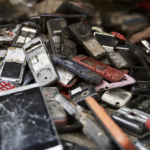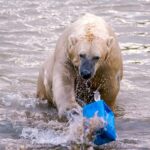The uncertainty surrounding sustainable agriculture
By Laura H. Kahn | June 20, 2011
All of our planet’s problems began 10,000 to 15,000 years ago with the domestication of livestock and crops, and it went downhill from there. While agriculture provided a stable food supply, it also required the destruction of pristine land. Surplus food enabled the growth of cities; cities led to civilizations; and civilizations eventually discovered the science and technology that allowed our numbers to grow. And, while these advances have been great for us humans, they haven’t been so great for the natural world. We have taken from nature and left our amassing waste in the land, oceans, and air — poisoning our planet.
Obviously, rather than constantly taking from nature, we must protect it and preserve it. But what does that mean? Should humans return to a hunting-and-gathering lifestyle? Some populations do hunt and eat bush-meat, but it is hardly pragmatic for the modern age (never mind the fact that many of the animals hunted, killed, and eaten are endangered species). Besides, historically, hunting and gathering provided a tenuous food supply at best. Before the development of agriculture, humanity was but a tiny fraction of the globe’s creatures. Researchers estimate that around 1.2 million years ago, the size of the human population was a mere 18,500 individuals — less than the number of chimpanzees and gorillas at the time. In fact, as recently as approximately 40,000 years ago, humans were almost at the brink of extinction — with only an estimated 2,000 individuals left — possibly due to severe droughts. No one wants to go back to that.
So, though all of our planet’s problems may have started with the domestication of livestock and crops, some form of agriculture is clearly needed to feed the growing global human population. Indeed, the United Nations has recently revised its estimates for the global population: increasing from 10.6 billion in 2050 to a whopping 15.8 billion in 2100 if the high-end estimates prove true. This unprecedented growth poses significant sustainability challenges — not least of which is: How do we feed all of these people without destroying our arable land and usable water?
The United Nations estimates that the percentage of land suitable for agriculture has been leveling off over the past two decades, and the impact of climate change on land use remains unclear. In other words, we may have too little land for too many hungry people. Meanwhile, only 1 percent of the freshwater on the planet is usable and available through the water cycle: evaporation, condensation, storage in the atmosphere, precipitation, and storage in ground reservoirs. We depend on that water cycle for all of our needs, and unfortunately, the reservoirs of groundwater that are critical to our survival are being pumped dry. Arable land and usable water are finite — which means that despite our growing needs, the resources available to sustain humanity are limited.
I have previously outlined the dangers of destroying the environment and leveling forests and vital ecosystems to make room for more farms as well as the risks of packing hundreds — if not thousands — of animals into farms. So, given that our basic needs for food, water, air, shelter, clothing, and energy will only increase, what can be done to both mitigate the environmental impact on the planet and meet the needs of our growing population?
Is sustainable agriculture the answer?
In 1990, Congress passed the Food, Agriculture, Conservation, and Trade Act, which included the term “sustainable agriculture” — which is loosely defined as a method of integrating animal- and plant-production practices by using a systems approach — whatever that means. The goal of sustainable agriculture is to satisfy human food and fiber needs, make efficient use of nonrenewable resources, enhance environmental quality, sustain the economic viability of farms, and improve the quality of life for both farmers and society.
Despite the vagueness of the concept, it has been embraced by many agricultural experts and nongovernmental organizations (NGOs), but as one NGO, Sustainable Table, states: “The definition is more a philosophy or way of life than a strict set of rules. … There is no legal obligation to follow any of the criteria of sustainability, so food can be labeled sustainable when in actuality it isn’t.”
But the only way to feed billions of people is through an actual highly efficient, economically sound, and environmentally friendly agriculture program — not just a label. We need to implement real-world agriculture policies and practices on a global scale — instead of just philosophizing. For example, after recognizing the hazards of deforestation to make way for big agriculture, the Brazilian government passed a forest-management law in 2006 mandating that all public forests remain public and establishing a Brazilian Forest Service responsible for protecting and maintaining these public forests. The Brazilian government also created Sustainable Forest Districts using local governance, law enforcement, land-use reform policies, education, and new technologies to stimulate economic growth and forest recovery. And as Brazil protected its forests, its agriculture industry began to boom through careful research, investment, and innovative farming practices. Countries would do well to examine Brazil’s efforts. (One alternative to sustainable agriculture could be test-tube meat — should it become technically, economically, and socially viable.)
In the mid-1960s, food shortages prompted investments in agricultural research that produced the Green Revolution, which led to the development of high-yield grains such as rice and wheat. While widespread hunger was averted, the advances in agriculture came with problems, too: such as environmental damage, excess use of fertilizers and pesticides, dead beneficial insects (e.g., bees), groundwater depletion, and polluted waterways. It’s time we figured out how to feed the planet without first destroying it.
We need a new revolution in global agriculture; “sustainable agriculture” must be better defined if it is to be understood and useful. We need to invest in agricultural research that will continue the benefits of the Green Revolution without the damaging costs. Achieving an equitable system of food distribution will require policy decisions on how to divide a finite amount of grain to meet global human, livestock, and energy needs. Limiting grain for livestock and energy to feed more people would probably require the price of meat and energy to dramatically increase, resulting in decreased availability for many. It is unlikely that any policy maker will be willing to make such politically difficult decisions. At the same time, an even greater challenge awaits us: Will we be able to feed billions and preserve the natural world?
Together, we make the world safer.
The Bulletin elevates expert voices above the noise. But as an independent nonprofit organization, our operations depend on the support of readers like you. Help us continue to deliver quality journalism that holds leaders accountable. Your support of our work at any level is important. In return, we promise our coverage will be understandable, influential, vigilant, solution-oriented, and fair-minded. Together we can make a difference.
Topics: Biosecurity, Climate Change, Columnists















